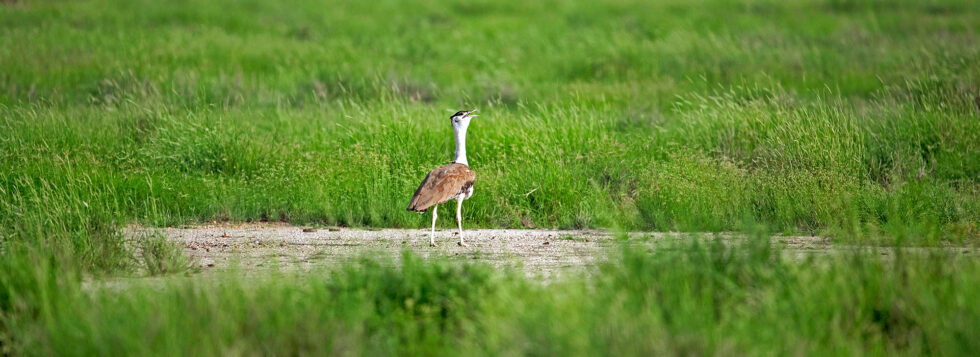The Gulf of Kutch Marine National Park and Sanctuary
Embarking on a journey from the Jamnagar jetty, you glide over the saltwater that covers 70% of our planet. On this voyage, as the tides are high, the universe seems to align as you witness a pod of dolphins surfacing nearby. During the winter months, you may be graced with the sight of thousands of migratory birds soaring overhead in a spectacular V-formation. With a keen eye, you might catch a glimpse of a kingfisher diving into the water for its morning meal. As you approach the islands, you will notice the intriguing sight of mangrove trees with their roots protruding from the water, providing a haven for birds wading among the roots and perched in the branches.
As the tide recedes, a vibrant and fragile ecosystem is revealed, inviting you to explore a mesmerizing underwater forest teeming with fantastical creatures adorned in brilliant colors, patterns, and textures. These scenes bring to life the imagination of your childhood, with every creature a reminder of the wondrous beauty of nature. When the tide turns once more, the beach becomes a bustling haven for numerous birds that feast on the marine life left behind by the waters.
Exploring the Islands
The ferry ride from Jamnagar to the islands is an experience in itself, offering spectacular views and the opportunity to observe a variety of bird species across different habitats. Upon reaching the islands, consider exploring on foot or inquiring about additional boat tours to discover more of the archipelago.
Please note that entry to the islands requires permission, and it is highly recommended to engage a guide. This enhances your experience and ensures the protection of the sanctuary’s delicate ecosystem, which can be heavily impacted by visitor activity. For permissions, fees, and other details, contact the Conservator of Forests Office at Tel: 0288 2679355, Nagnath Gate, Van Sankul, Ganjiwada, Jamnagar.
Historical Significance
The Gulf of Kutch was designated as India’s first Marine Wildlife Sanctuary in 1980 and later as the first Marine National Park in 1982. These designations marked a significant shift in societal and governmental awareness of the importance of preserving natural environments. Covering an area of 458 sq km, with the park itself spanning 163 sq km, the sanctuary is a collection of 42 tropical islands along the northern coast of the Jamnagar district and the southern coast of Kutch.
Located within the intertidal zone between the lowest and highest tide levels, the sanctuary offers a unique opportunity to observe the rich diversity of marine habitats, including saline grasslands, marshes, rocky shores, mudflats, creeks, estuaries, sandy strands, coral reefs, and mangroves. Coral reefs and mangroves are essential for maintaining the local environment’s stability and diversity and for the planet’s ecological health. The 2004 tsunami underscored the importance of mangroves, as areas with intact forests fared better than those without.
Coral Reefs and Mangroves
Some of the finest coral reef fringe islands can be found at Pirotan, Narala, Ajad, and Positara, featuring 52 coral species, 42 of which are hard corals and 10 soft corals. Corals consist of millions of tiny, colorful animals called polyps, which are bound together by algae and other plants. This symbiotic relationship enables high nutrient turnover, akin to a tropical rainforest, providing shelter and breeding grounds for a multitude of marine species.
The sanctuary is also home to seven species of mangroves that play a vital role in maintaining the balance between salt and freshwater systems and protecting the coast from erosion. These mangroves serve as breeding grounds for near-threatened bird species like the Painted Stork, Darter, and Black-necked Ibis. The branches of the mangroves are filled with various bird species feeding on fish and invertebrates attracted to the protein-rich leaf litter. Other birds, such as Avocets and Phalaropes, can be seen wading in shallow waters, while species like Gulls, Terns, Kingfishers, Ospreys, Marsh Harriers, and Palla’s Fish Eagles soar over the open waters in search of their next meal.
Diverse Wildlife and Ecosystem
At low tide, the sanctuary reveals a rich array of marine life, including giant sea anemones, which host symbiotic shrimp, over 40 species of colorful sponges, starfish that can shed their arms as a defense mechanism, sea cucumbers that expel their internal organs to deter predators, and octopuses that camouflage themselves. Other fascinating residents include pufferfish, which inflate to ward off threats, mudskippers, crabs, mollusks, sea slugs, and echinoderms, each decorated with vibrant colors and intricate designs.
The beaches along the Gujarat coast are vital breeding grounds for the Green Sea Turtle and other marine turtles. In the deeper waters of the sanctuary, the majestic whale shark, the largest fish in the world, feeds on plankton. Unfortunately, this magnificent creature is endangered due to being hunted for its flesh and cartilage oil.
Conclusion
The Gulf of Kutch Marine National Park and Sanctuary is a must-visit destination for nature lovers, birdwatchers, and anyone interested in exploring the wonders of the marine world. Its unique landscape, diverse flora and fauna, and the opportunity to witness the beauty of the underwater ecosystem make it an unforgettable experience.





